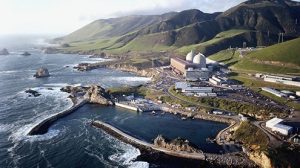Impact of Diablo Canyon closure needs studying
IN THIS ARTICLE
- Editorials Topic
- Henry Dubroff Author
By Editorial board and Henry Dubroff Friday, April 29th, 2016

Diablo Canyon Nuclear Plant near San Luis Obispo County’s Avila Beach is the last operating nuclear plant on the West Coast. (photo courtesy of PG&E Corp.)
We didn’t pull any punches when we wrote about California’s war on business in the April 22 edition of the Business Times.
For a classic example of the kind of thinking that’s just wrong about California’s path forward, it’s worth looking at opposition to SB 968.
Introduced by Sen. Bill Monning, a Democrat from Santa Cruz, the bill would require PG&E and the California Public Utilities Commission to conduct an independent, in-depth study of the economic impact of closing the Diablo Canyon Nuclear Plant, the only nuclear power station on the West Coast.
It has drawn broad-based support, has Sen. Hannah-Beth Jackson, a Santa Barbara Democrat, as a co-sponsor, and an amended version is slated for a committee hearing on May 2.
But the bill isn’t enough for a couple of fringe anti-nuclear groups who have been vocal in their opposition. Their agenda is to end nuclear power production on the Central Coast without regard to economic impacts or the fact that Diablo Canyon has an operating license that’s good until the middle of the next decade.
What the Monning bill does is begin the hard work of finding a new way forward for the San Luis Obispo County economy in the event the plant is closed. Diablo Canyon is the county’s largest non-government employer, it has an impact of around $1 billion in 2013 dollars and, to date, no study of how to mitigate the impact of a possible plant closure exists.
For those who haven’t kept up with the Diablo Canyon story, PG&E and the Nuclear Regulatory Commission have been reassessing seismic risks in the wake of the Fukushima disaster in Japan and the discovery of new faults offshore. Meanwhile, state regulators have been assessing the environmental impact of the discharge of warm water into the Pacific Ocean.
The point that the opponents of the study miss is that SB 968 doesn’t render a judgment on nuclear power. What it calls for is a well-reasoned assessment of how SLO County can move forward economically if the plant is closed. Given that Diablo Canyon is now within a decade of possible closure under its current NRC license, it seems like the perfect time to be thinking about what’s next.
The opponents of such a study are knee jerk opponents of anything that might benefit private sector jobs. And that’s exactly what California’s war on business is all about.
Desalination plant looks viable
The city of Santa Barbara and the Montecito Water District have been holding discussions about using some of the water from Santa Barbara’s desalination plant to help the wealthy hamlet alleviate a severe water shortage.
While it’s too early to say what a final agreement might look like, the talks do underscore one reason why this time is different when it comes to desalination and drought relief. The plant, now under reconstruction, will be a lot more productive than the original design from the 1990s when it becomes operational.
And that means Santa Barbara could supply water to surrounding towns or even, at least theoretically, to those at some distance. Selling water or water rights at attractive rates was not feasible a couple of decades ago.
But in 2016, the prospect of a few transactions along these lines makes the desal plant look less like a white elephant and more like a viable enterprise.










